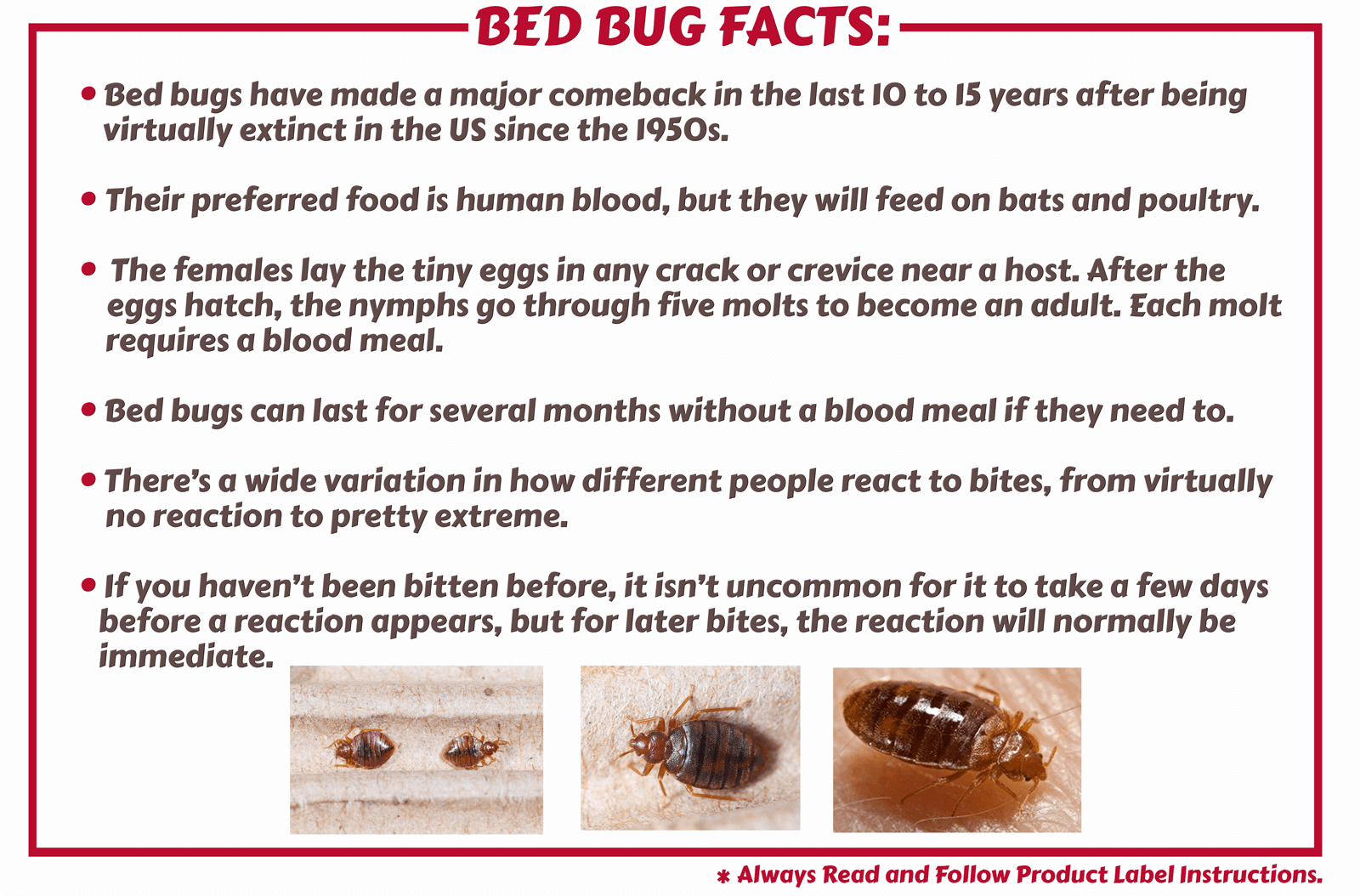Bed bugs are oddly interesting little buggers, in the sense that their biology, feeding habits and reproduction cycle are very intriguing. A lot of people don’t know that there are actually different types of Bed Bugs, with the Cimex lectularius (AKA Common Bed Bug) being the most common type in the United States today. They are also a world wide menace, as they infest properties all over the world in surprisingly large numbers. However, we aren’t here to talk about how interesting bed bugs are, but rather about just how interesting fun bed bug facts can be! I wasn’t sure whether I should post these fun facts or not. I mean, some of them just aren’t… um… nice? But then I thought to myself, maybe if we make light of it, we can take our minds off the terrible ways bed bugs bite into our skin and leave their ooze. If you have a story about your battle with bed bug bites but you can’t tell it because someone found it offensive, email me and I’ll let you know when it’s okay to post it here…
Bed Bug Fun Facts
Bed bugs were once considered a form of stinging insects.
The word “bed bug” comes from the fact that these insects were once considered a form of stinging insect.
In the past, bedbugs were mistaken for ticks or chiggers—but they can also be mistaken for mosquito bites. Some people refer to bed bugs as “kissing bugs” because of their tendency to feed on human blood when humans are asleep in bed (or sitting quietly in a dark room).
You can tell if you have bed bugs by looking for blood spots on sheets and mattresses.
The best way to determine whether or not you have bed bugs is by looking for blood spots on sheets and mattresses. Bed bug fecal droppings are dark red in color and resemble small dots. If you find these blood spots, look for bed bugs under the sheets, which are typically found in dark areas such as the corners of your room or underneath the headboard of your bed. You can also inspect cracks and crevices around baseboards for signs of bed bug activity—they prefer secluded areas where they can hide from light sources.
If you find any evidence of an infestation, contact a pest control professional immediately so that they can inspect your home thoroughly and help eradicate this problem before it becomes too much trouble!
Bed bugs can bite at any time, but they’re most active at night while you sleep.
Bed bugs can bite at any time, but they’re most active at night while you sleep. Bed bugs are nocturnal creatures that feed on human blood while you’re sleeping.
There are no symptoms of bed bug bites other than the red bumps that appear.
Though the bites are not harmful, they are itchy and irritating. The redness and swelling that occur around the bite is caused by a skin reaction. You may not even know you have bed bugs until they have bitten you. Even if there are no other symptoms, some people don’t notice them until they see them.
Lyme disease is what causes the redness and swelling of the bites, leading to a skin rash.
Lyme disease is caused by the bacteria Borrelia burgdorferi. It is transmitted to humans through the bite of infected blacklegged ticks. This can take place anywhere in North America, but it is most common in the Northeast and upper Midwest regions of the country. The first symptom of Lyme disease is usually a red skin rash that appears around 3-30 days after being bitten. Other symptoms include fever, headache, chills and fatigue
It’s important to note that Lyme disease isn’t contagious; you can only get it if you are bitten by an infected tick. Lyme disease is treated with antibiotics such as doxycycline or amoxicillin.
Lice don’t carry diseases. Just because someone has lice doesn’t mean they’re infected with any disease.
Lice are not dangerous. The Centers for Disease Control and Prevention (CDC) states that head lice are not known to spread disease, and there’s no evidence of a connection between lice and disease. Lice can cause itching, irritation and discomfort if they live on or near the scalp; however, their presence is not a sign of poor hygiene or uncleanliness.
Bed bug bites are often confused with mosquito bites, but they look different and will turn into welts rather than red blisters.
If you think you’ve been bitten by a bed bug, consider the following:
- Bed bug bites often look like a small red dot or a red bump. These bites can also turn into welts. If you find bite marks on your arms and legs, check to see if they are surrounded by hives or sores that itch. This would indicate bed bugs as the culprit.
- Mosquito bites usually look like two little points in an “X” shape–or they may be red and swollen but not itchy at all (meaning that they were mosquito bites). In most cases, mosquito bites will not turn into welts like those caused by bed bugs; instead, they’ll remain small and less noticeable over time because of their symmetrical nature (mosquitoes tend to bite people in groups). Mosquito bites also tend to occur on exposed areas of skin (arms, legs), whereas bed bug bites are often harder to detect on dark-colored clothing such as blue jeans or black pants because they don’t leave any visible marks behind after healing up completely within 48 hours of being bitten by one insect versus another
There are some things you can do to stop an infestation from happening, especially if you think it is already happening.
If you think that you may have a bed bug problem, there are some things that you can do to stop an infestation from happening.
- Use a vacuum cleaner to get rid of any potential bed bugs. This is especially important if you think the bugs were brought home on your clothing or luggage.
- Keep your bed clean and make sure it is not dusty or dirty. Bed bugs prefer clean, tidy environments where they can hide without being disturbed by people moving around during the night.
- Wash all sheets and blankets before putting them back on the bed after washing them in hot water with detergent for at least 30 minutes (the hotter the better). Make sure everything gets completely dry before using it again; otherwise, some bedbugs might survive even this treatment! If possible use an extra-high heat setting (150 degrees F) for 10 minutes at least once every few weeks just in case there are any eggs left behind which might hatch later on down the road…
Additional Info :
| Item Dimensions | |
| Height | 8 Inches |
| Width | 0.75 Inches |
| Length | 8 Inches |
| Weight | 1.05 Pounds |
| Release Date | 2020-12-29T00:00:01Z |
Additional Info :
| Release Date | 2016-10-20T10:18:38.344Z |
- Over 2400 FREE photos
- Puzzle sizes (9 to 1300 pieces) are all free, and also you can use piece rotation to make it harder
- Play with your own Custom Photo from your device
- Cloud Save option
- Also: Random interlocks design, auto-save, elegant design, landscape support…
Additional Info :
| Release Date | 2018-11-03T18:46:07.000Z |
Additional Info :
| Item Dimensions | |
| Height | 9 Inches |
| Width | 0.25 Inches |
| Length | 6 Inches |
| Weight | 0.35 Pounds |
- Protects Against Urine, Fluids, Perspiration
- Cotton Terry Surface With Membrane Back Coating (Waterproof, Noiseless and Breathable)
- Great For Those With Kids, Pets Or Incontinence (OEKO-TEX Certified SH025 151792)
- Will Not Change The Feel of Your Mattress (Registered with the FDA as a Class 1 Medical Device)
- Fitted Sheet Style Design – Queen Size Mattress Protector 60″ x 80″ – Fits up to 18″ deep
Additional Info :
| Color | White |
| Item Dimensions | |
| Height | 11.1 Inches |
| Width | 3.6 Inches |
| Length | 11.5 Inches |
| Weight | 1 Pounds |





